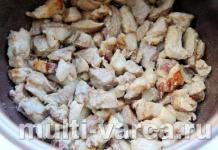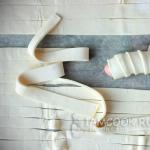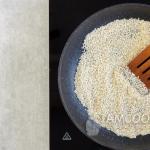Wallpaper for walls is the simplest and one of the most effective options for decorating the inside of a house. Among the huge selection of colors, textures and various effects, you can find exactly what will reflect the interests and mood of the owners of the house, and the ability to color and combine various materials allows you to create a completely unique design.
Pros and cons of decorating walls with wallpaper
Wallpaper is the most common method of finishing walls in residential premises. Construction stores offer an incredible variety of colors, textures and materials, which allows you to choose the ideal option taking into account the characteristics of the apartment.
| Pros | Cons |
|---|---|
| Firstly, the advantages include a wide selection of colors and various effects. Today you can make a selection to suit any style, with imitation of various materials and absolutely any image, from a nondescript ornament to a complex artistic 3D image. | Despite all the positive qualities, wallpaper for walls still cannot boast of such durability as, for example, ceramic tiles. Only a few species can withstand animal claws and other household damage. |
| Variety in price can also be considered an advantage. The cost of wall coverings depends on the characteristics and type of material and some of them are quite expensive, but the price range starts with very budget models. | Walls of shower areas and open balconies cannot be finished. |
| Not all types have a long lifespan, although some reach 30 years. | |
| The variety of types allows finishing in rooms with different conditions, for example, high humidity, abundant lighting or possible frequent mechanical damage. | Some types are almost impossible to wash from various types of contaminants. |

Types of wallpaper
Each type of wallpaper for walls has its own distinctive features, different characteristics, composition and external effects. If you have some doubts about the choice of material, then there is one, thanks to which you can settle on the most optimal option, taking into account all the nuances of the room.
- Paper. Budget type of wall decoration with a large selection of colors and patterns. The material has poor strength and durability, fades in the sun, absorbs odors and is practically not suitable for any cleaning. Paper ones are suitable for finishing enclosed spaces with the least possible contact, for example a bedroom or the upper part of a nursery, a corridor with a horizontal finishing method.
- Non-woven. This species can be divided into two subspecies. Fully non-woven wallpaper with a non-woven base. The first type is most often used for painting. It has a varied relief texture that can match almost any stylistic direction. The second type has a top layer of vinyl, they do not need to be painted, the surface can have a different pattern and color.
- Vinyl. This popular type of wallpaper for walls is durable and strong. Vinyl coating is made in different variations with different external effects: silk-screen printing, foamed, hard vinyl. The surface is suitable for wet cleaning and finishing of any premises.
- Liquid. This type is different from all the others. They are purchased in powder form and diluted in water before use. Liquid wallpaper is applied to walls like plaster, which avoids joints on the surface. The material breathes and goes well with other methods of wall decoration.
- Glass wallpaper. The most durable type of all listed. The composition uses glass, which under the influence of high temperature is drawn into fibers, and then turns into canvas. Fiberglass wallpaper for walls is most often used for painting. The coating has a breathable surface, is suitable for repeated painting, and is not afraid of mechanical damage and high humidity.
- Textile. The material has a base and an upper textile covering, which can be made of different materials. The wallpaper has excellent appearance and natural composition, protects against noise and does not react to sunlight. However, dust can settle on the surface, with the exception of linen coverings and the material absorbs odors.
- Linkrusta. Wall coverings of this type are not so widely popular, but their quality characteristics are superior to other materials. The composition of linkrust is absolutely natural, based on wood. The coating is not afraid of mechanical damage and high temperature, has a long service life and an elegant appearance.
- Natural. This type includes bamboo and cork coverings, which are made from natural raw materials. The materials, first of all, are environmentally friendly, resistant to changes in humidity and temperature, and are suitable for finishing balconies and verandas. Natural wallpaper for walls does not differ in the variety of colors and textures.
- Photo wallpaper. Wallpaper with photo printing will make the interior unusual, stylish and individual, and will also successfully cope with the issue of space zoning. The drawing can be close to the real image (cities, flowers, animals), with a 3D effect, stereoscopic or expand the space.

The photo shows a modern bedroom interior, the walls are decorated with wallpaper with a three-dimensional pattern.



Color range
Table of the most popular colors
Mother of pearl
The iridescent surface will look interesting in the light, and if a relief pattern is applied, it will create a play of light and the illusion of volume. Mother-of-pearl wallpaper for walls can be in the form of an imitation of Venetian plaster or silk-screen printing. Both options suit different styles and look impressive.

The photo shows mother-of-pearl walls in blue tones.
Mints
A refreshing shade is suitable for decorating rooms with south-facing windows. The color is like a fusion of light turquoise and blue shades, it will look good in modern, Scandinavian, Provence, shabby chic styles.



Wallpaper styles in the interior
Provence
Beautiful and delicate style focuses on a combination of elegance and rustic simplicity. The design uses pastel shades, a touch of antiquity and natural materials. Light wallpaper with a discreet floral or floral pattern is used for the walls. Plain liquid wallpaper with an imitation of bleached brick or wood will also look good.

Loft
The modern trend offers a fairly rough finish for the walls or its imitation. The idea of the loft direction combines the atmosphere of open industrial premises and home comfort. Wallpaper for walls imitating concrete, brick, plaster or wood will look harmonious in the interior; the color palette is close to the shades of the materials, although it does not exclude the use of bright accents.

The photo shows a loft-style bedroom, the walls are decorated with wallpaper with ornaments.
Classic
The classic style is not characterized by the use of bright flashy shades. For the walls, a palette with restrained muted colors is used. The pattern can be different, for example damask, monograms, stripes, floral or floral patterns. Plain wallpaper under plaster will look no less successful. For neoclassicism, you can add geometric patterns and photo wallpaper.



Baroque
The Baroque style is characterized by luxury in details. The color of the walls can be light and calm or a rich deep shade. The walls are decorated with monograms, damask and ornate floral patterns. The design will look harmonious with textile, fabric, vinyl silk-screen printing and linkrust wallpaper.

Art Deco
The style is filled with chic and luxury in every detail, while it is elegant and sophisticated. Wallpaper for walls has a beautiful deep shade; it can be light or dark; bright flashy colors will be inappropriate. Stripes, floral patterns or geometric patterns are suitable as a pattern.

The photo shows a combined black and silver wallpaper.
Scandinavian style
The design of the room is filled with light, natural materials and simple shapes. For walls, wallpaper in white or light pastel shades is suitable; you can also use photo wallpaper. The ornament is simple, it can be with floral motifs or in the form of geometric shapes, such as zigzag or stripes.



Modern style
For a modern design, you can choose bolder shades, such as lemon and blue, or stick to a calm palette, focusing on the details. Patterns imitating other materials, plant and floral prints and geometric shapes will look harmonious in the design of the walls.




The photo shows striped wallpaper in a teenager's room.
English style
Refined English style does not tolerate bad taste and overload in details. The walls are decorated with wallpaper in subdued colors with small patterns or stripes, which can be combined with natural wood.

Eastern style
Both directions belong to the oriental style, but each has its own distinctive features.
Chinese
Chinese-style decoration can be done with wallpaper for walls depicting birds, a flowering tree or flying dragons.



Japanese
In the Japanese style, you can focus on natural materials and minimalist forms. Natural wallpaper made of bamboo or fabric is suitable for decoration. The wall covering can be plain or colored, textured or with a thematic pattern (for example, sakura).



Art Nouveau style
Elegant and expensive style. The design uses a combination of natural materials such as wood, stone and glass. For walls, wallpaper with a palette close to natural colors is suitable: brown, beige, gray, white, gold and silver.

Country
Country style. The interior uses natural materials, simple shapes and cozy details. Wall decoration can be with a floral or floral pattern, stripes or checkered patterns.
The photo shows a country style kitchen, the walls are decorated with blue floral wallpaper.
Vintage
Design with a touch of antiquity. For wall decoration, paper or fabric coverings with imitation boards, large plant and flower patterns or images of butterflies and birds are suitable.


Other types
Pop art
A playful design, wall decoration in which can be in the boldest colors, using large drawings from comics or geometric shapes.


The photo shows bright wall decoration in pop art style.
Mediterranean
A style that exudes sea freshness. By the nature of its design, the Mediterranean style has much in common with the Greek one. The finishing is done in natural colors, white, blue, sand, terracotta. The pattern is suitable with a marine theme, imitation tiles or stripes.

Steampunk
The unusual style combines scientific and fantasy themes. Photo wallpapers depicting large metal clocks or mechanisms are ideal for wall decoration.

Shabby chic
Playful doll-like design. Filling and finishing are done in pastel colors: mint, peach, pink, green. Undoubtedly, floral prints, large and small, are used as designs.

The photo shows soft turquoise wallpaper with roses in the shabby chic style.
Patchwork
For patchwork interior decoration, wallpaper with an imitation of many patches is used. They can be different colors and have different patterns, but must be combined with each other.



Retro
Retro-style decoration can be in bright colors, using geometric shapes or repeating patterns.


American
Wallpaper for walls in the American style is plain or with a discreet pattern; moldings in light colors are suitable for design.

Photos of wall decoration in the interior of rooms
Living room
The hall can be decorated with either one type of wallpaper or different materials. In a small room, both options are suitable. In the interior of the living room, you can combine different patterns and colors, highlighting some areas with the help of photo wallpaper or zoning the space.

Bathroom
For bathroom walls, it is imperative to use a material that is resistant to high humidity, such as fiberglass or vinyl. For greater reliability, it is better to combine the finishing with painting or wall panels.
Kitchen
The color of the walls should be combined with the kitchen set; these can be harmonizing shades or similar colors in the elements. For the kitchen it is recommended to use washable wallpaper. The dining area can be decorated with wallpaper with a large pattern, kitchen photo wallpaper, or, conversely, with a nondescript ornament.

Bedroom
Decorating a bedroom can be done in different ways: with photo wallpaper, completely in one color, highlighting the sleeping area, finishing the wall above the head of the bed with a different color, or combining different coverings in a horizontal way.

Children's
In a child's room, a good idea would be photo wallpaper, options with playful pictures or just different colors. Shades should be used that are not too bright, but positive.

Hallway and corridor
For the walls of a closed hallway or with low lighting, it is worth using a light color of wallpaper; they can be combined with artificial stone or brick. In open rooms, you can focus on color, highlighting, for example, one of the walls.

Toilet
Toilet walls require coatings that are highly resistant to moisture and mechanical damage. The best solution for decorating a standard or small room would be a light palette or photo wallpaper that increases the space.

Balcony and loggia
Considering possible frequent temperature changes, it is better to use materials that are heat- and moisture-resistant for the walls of the balcony, as well as those that do not fade in the sun. Wallpaper for a balcony made of cork, bamboo, or photo wallpaper will look interesting.

Other rooms
Cabinet
The work room should be decorated with wallpaper, the color of which will stimulate activity, for example blue or gray. The design should not be distracting or provocative; a simple ornament will be enough.



The photo shows checkered wallpaper in a classic office interior.
For dressing room walls, you should choose a finishing material that is resistant to mechanical damage. The color can be anything from a playful print to a simple plain neutral shade.



The photo shows brown wallpaper with a gold pattern in the dressing room.
Billiard room
For the walls of the billiard room you will need wallpaper with sound insulation and increased strength, for example cork or fabric. The color should be muted and dark so that it does not interfere with the game.



The photo shows striped fabric wallpaper in the billiard room interior.
Attic
A room on the attic floor is a separate cozy corner in the house. The walls can be decorated with wallpaper with a small floral or floral pattern, wood imitation or a calm plain canvas.



In the photo, the walls in the attic are decorated with photo wallpaper.
In a private house
Ladder
The walls of the staircase are decorated depending on the style of the house. The decoration can be in the same color scheme as the rest of the room or become a bright accent due to color or a large pattern.





Dining room
Wallpaper for the walls in the dining room should be conducive to a pleasant pastime. The pattern and color are determined by the style of the dining room, but it is better to stick to light shades and unpretentious prints.



Hall
It is better to choose a calm drawing, without bright elements, although in some styles, for example pop art, this would be quite appropriate.



Design options, patterns and patterns
There are many options for decorating a room using regular wallpaper. Finishing can be done with one type of wallpaper; for this it is better to use monochromatic, textured or finely patterned coatings.
In one room you can combine different colors, patterns or textures; companion wallpaper is suitable for decorating any area and, when used correctly, corrects the shortcomings of the space. Designer advice can help with this. It is also common to highlight an accent wall with contrasting wallpaper. They will also help to visually divide the passage room into zones, without compromising the area.
Drawings and patterns should reflect the stylistic idea in the interior.
- Monograms, damask and striped wallpaper can decorate many styles, from classic to modern elements.

How to choose the right wallpaper?
Simple rules and some tricks will help you choose the best option for finishing.
- For a small room, you should choose a light palette for decoration.
- Wallpaper with stripes, depending on the direction, will visually make the room taller or wider.
- To visually bring the wall closer or reduce the space, wallpaper in bright colors and with large patterns is suitable.
- For rooms with high traffic or a high probability of mechanical contacts, it is better to choose anti-vandal coatings.
- Washable coatings with high moisture resistance are suitable for the kitchen, bath and toilet: vinyl, fiberglass, liquid, self-adhesive.
- For a nursery, you should choose the safest possible material; eco-friendly wallpaper, such as cork, glass wallpaper, or bamboo, is suitable.
- For a country house and cottage, you need to choose a material that is not afraid of temperature changes and humidity.
- The color palette should reflect the character of the owner; to decorate a women’s room, you can choose delicate pastel and light shades. Brutal cold shades are suitable for a masculine interior.
- For those who are interested in Feng Shui, it is worth paying attention to colors, each shade has its own meaning, for example, white clears the mind, blue inspires, and green has a calming effect.

Rules for decorating walls with wallpaper
When working with wallpaper, you must follow simple, but still rules.
- It is necessary to apply wallpaper only to the prepared surface; the walls must be cleaned, leveled and primed,
- The glue must be selected in accordance with the characteristics of the material; for some types, glue for heavy types of coatings will be needed.
- When choosing wallpaper for walls, you need to take into account the features of caring for them. To do this, a marking is placed on the back of the roll or package indicating the degree of interaction with moisture.
- Structural wallpaper for walls designed for this purpose, such as fiberglass or non-woven, is suitable for painting.
- It is important to pay attention to the symbols on the packaging; they greatly simplify the choice.
- When combining wallpaper for walls, you need to select canvases of equal thickness and preferably from the same manufacturer.
- Regular maintenance can extend the life of the coating and maintain its appearance.
Photo gallery
Wallpaper is deservedly the most popular type of decoration for residential premises. A variety of textures and a wide selection of colors allow you to choose an option that will ideally suit the personal needs of the owner. Different manufacturing technologies and materials make it possible to decorate with wallpaper in almost any room of the house.









No matter what modern finishing materials appear on the market, for most Russians wallpaper remains the main option for decorating walls in rooms with a wide variety of purposes. Practical and inexpensive, easy to install and use, with a wide choice of colors and textures - using wallpaper is the easiest and fastest way to refresh the decor of a room or radically change the design. But there are also many varieties of this finishing material. Therefore, it is important not only to choose the right print, color scheme of the finish, but also the raw materials from which the canvas is made. The aesthetics, durability, strength and ease of maintenance of the decorated walls will directly depend on the properties of the wallpaper.

Fashionable design 2017
All areas of our lives are affected by fashion trends. Clothing designers easily change color priorities; new trends exclude previous, recently most relevant ideas. In the field of decorating residential spaces, to the delight of ordinary people, the change in trends does not happen so quickly - the created renovation can be relevant for several years. But “keep your finger on the pulse” is necessary for everyone who has decided to make a major renovation or minor reconstruction of their home.



What wallpaper can be considered the most stylish in the new 2017? What color and texture will be relevant and modern? Luckily for us, there is no clear answer to these questions. Too many factors influence the choice of finishing materials in rooms with different functional purposes. Not to mention the personal preferences of designers and their customers - some prefer timeless classics and are ready to spend money, for others it is important to maintain the family budget, and still others need ultra-fashionable design. And yet, among the latest trends in the field of finishing materials, the most popular trends can be identified:




usage plain wallpaper. This approach is chosen not only by conservatives or those who are just starting their journey in creating the design of their own home. Light, plain wallpaper may be the only acceptable option for decorating a very small room. In other cases, the walls act only as a backdrop for wall decor - a collection of framed photos or paintings. Using bright, solid wallpaper can be a great way to decorate an accent wall;


geometric print is trending now. Depending on the size of the room, the level of illumination (location relative to the cardinal directions) and stylistic design, you can use either a small and colorful print or a large but barely noticeable pattern;





plant pattern on canvases made from various raw materials. Paper wallpaper, vinyl or textile - floral print is always relevant. The nuances of using plant motifs for the new season are mainly associated with dosed use. If earlier our compatriots often covered all the walls of the living room or bedroom with wallpaper with a large floral pattern, now the finishes are combined, and the pattern or ornament is used as a material for an accent surface;





practicality, functionality and aesthetics are always in fashion, so modern designers give preference wide wallpaper. The wider the canvas, the fewer joints there will be on the walls;




for reasons of ease of installation and operation liquid wallpaper are becoming increasingly popular.


Popular materials
Wallpaper fabrics are made from various materials. Thanks to the wide variety, the modern owner of an apartment or house can find an option that will satisfy him in terms of quality and cost. Obviously, for rooms with different climates and functional backgrounds, it is necessary to choose wallpaper with a certain composition. But there are many universal options that can become practical, durable and aesthetic wall coverings in a variety of rooms. What types of wallpaper are considered the most popular these days?




Most modern owners of houses and apartments planning renovations or minor alterations choose non-woven wallpaper (or vinyl on a non-woven backing). High strength, durability (relative to other types of fabrics) and a wide range of colors and textures are becoming the main criteria for choosing this type of finish for modern homes. The advantage of gluing walls with non-woven wallpaper is that you only need to apply glue to the wall - there is no risk of the canvas getting wet, erasing the pattern or damaging the material. This material can be made for painting or already contain a print (pattern, drawing, ornament).






Liquid wallpaper is becoming increasingly popular. The application of such material is more reminiscent of painting. But unlike conventional painting, liquid wallpaper comes in a variety of textures and can have various additives and additives in a color different from the main tone. If the surface is prepared for finishing, then applying liquid wallpaper (removing your room from joints and seams) will not be difficult even for an inexperienced owner making renovations for the first time.


Textile wallpaper is most often used to decorate accent walls in bedrooms and living rooms. Luxurious performance, the ability to “breathe” and excellent sound insulation captivate home and apartment owners to use this expensive material. But the inability to clean the surface with a damp sponge and any cleaning agents prohibits the use of textile fabrics in rooms with a high level of possible contamination - children's rooms, kitchens, hallways and corridors, bathrooms and toilets.





There are other types of wallpaper that are used to decorate residential premises, but their popularity is significantly lower than the options listed. For example, paper wallpaper is highly environmentally friendly and is cheaper than all other wallpaper materials, but is completely impractical, short-lived and often looks “rustic” for creating a unique room design.



Color palette and print
In the new season, designers invite us to plunge into the world of complex shades of blue. The current colors will be sea green, whitened indigo, light blue, deep ultramarine. It is best to use different shades of blue in rooms located on the south side of the building and well lit by sunlight, because all shades of blue belong to a cool color scheme.




Gray color continues to be one of the leaders in the top list of the current color palette of 2017. The neutrality and versatility of most shades of this color allows it to be used as the main solution for the interior palette in a wide variety of rooms. Living rooms and bedrooms, hallways and offices - gray color is relevant in rooms with different microclimates and functional backgrounds. Even in a children's room, a gray tone can be used as a companion to a bright shade and get an original and at the same time unobtrusive room design. Colorful furniture, textiles and wall decor look very impressive against a neutral gray wall background.








Almost all shades of beige can be called neutral, warm. That is why beige tone is so often used when creating the design of small rooms, rooms located on the north side of the building, deprived of a lot of natural light. The light beige palette is perfect for decorating a bedroom – the calming and cozy atmosphere sets the mood for rest and relaxation. Pastel shades of beige will always be relevant.




Black and white print did not come into fashion yesterday and will not cease to be mainstream tomorrow. Graphic images often become the basis for the design of premises in different stylistic designs - from classic to avant-garde. Depending on the diversity of the pattern, the ratio of white and black colors in the pattern, canvases with graphic prints can be used both in spacious rooms and small rooms to highlight functional areas.







Wallpaper with a vertical pattern will help to visually increase the height of the ceiling in the room. Whether it will be a stripe or a vertical pattern is up to you. The main thing is that the “stripes” are not frequent, not colorful, and do not attract too much attention.




Metallic wallpaper or embossed canvases have not lost their popularity for several seasons. As a rule, wallpaper with a silver or golden tint is made with an ornate pattern (English, Windsor, Versailles pattern) or floral print. The luxury of embossed fabrics adds a touch of well-being, elegance and style to any interior. In classic, neo-classical interiors, such wallpaper can be used both to decorate all walls and to highlight certain areas within a combined room or a separate space that has several functional segments.





Combining wallpaper from different materials can lead to the creation of a not only original room design, but also a unique concept. For example, in classic and neo-classical interiors, the selection of zones decorated with embossed wallpaper and moldings looks luxurious. At the same time, the wallpaper, limited by moldings, can be made in the same color scheme as the main tone of the walls and differ only in the pattern, or they can appear in a contrasting, colorful version that stands out against the general background.



Photo wallpapers have not become less popular. It’s hard to think of a better option for highlighting an accent surface. High-quality image printing allows us to immerse ourselves in a beautiful landscape without leaving our own apartment. Or feel the warmth of home against the backdrop of bookshelves, admire a huge family portrait on the entire wall, or decorate a nursery with an image of your favorite fairy tale, cartoon, or comic book character.






When using photo wallpaper to create a modern interior, designers around the world especially often began to use various maps. This could be a map of the world or your city, a non-existent kingdom or a place where you were born and can now only be nostalgic.


Several universal options
We bring to your attention several wallpaper options that fit harmoniously into both the interior of residential and utilitarian premises. There are many modern paintings that look trendy in the living room, bedroom, office, dining room and even hallway. Modern materials are highly durable and wear-resistant, can be cleaned, do not fade in the sun, and last for many years with proper use. That is why many finishing options using wallpaper are suitable for rooms with different microclimates and functional loads.




And finally, another option for using the same wallpaper in different rooms of the home.


Modern wallpapers are distinguished by their attractive appearance and functionality. With the help of correctly selected material, you can hide uneven walls and visually change the dimensions of the room. To choose the right fashionable wallpaper in 2018-2019, you need to study the latest trends in design.
Characteristics of materials
Various materials are used to make wallpaper. A huge assortment allows you to choose the best option to realize your design idea.
The demand for previously popular paper webs has decreased significantly. Despite the low cost, buyers stopped choosing this type of material due to its fragility and poor quality.
Consumers increasingly prefer other types of wallpaper:
Prints and designs
The image on the wallpaper should correspond to the wishes of the homeowners and become an accent in the stylistic idea. Designers offer several interesting ideas, the use of which will make the room original.
Floral motifs
Natural motifs can be expressed in different ways: in the form of an image of a blooming garden, a tropical or deciduous forest, a park alley. The image of nature has many options:
- Wild Jungle;
- Blooming bouquets in vases or pots;
- Exotic plants, their foliage or flowers.
Such decor will fill the room with bright rich colors. To create a harmonious design with such wallpaper, you should opt for a neutral flooring color.

Tree patterns on gray wallpaper in the bedroom

Floral patterns on wallpaper





Geometric lines
This year, a separate niche is allocated to canvases with geometric images. The main role is given to hexagons and honeycombs. The use of such wallpaper allows you to visually balance the space, make it harmonious and holistic. The pattern on the wallpaper is duplicated in furniture upholstery or textiles. Honeycombs can enliven even the most boring interior and divide it into functional zones.


For those who like experiments and bold decisions, manufacturers have released canvases with multi-colored geometric shapes: rhombuses, triangles and zigzags. A wall covered with such material will become the accent of the room and will attract attention.






Plain geometric shapes on a dark background will fit perfectly into a glamorous retro style and will become an excellent backdrop for furniture made in a classic style.


Floral ornament
For several years now, images of flowers have been at the peak of fashion. The English style in the interior with rose bushes on the walls is extremely popular. 

 So that consumers can choose the right design, manufacturers produce canvases with flowers of various sizes - from small ornaments to bright colors of the maximum size.
So that consumers can choose the right design, manufacturers produce canvases with flowers of various sizes - from small ornaments to bright colors of the maximum size. 

 Exotic flowers, blurry garden flowers, like a watercolor drawing, picturesque bouquets - any of these options will look appropriate in the interior of your home.
Exotic flowers, blurry garden flowers, like a watercolor drawing, picturesque bouquets - any of these options will look appropriate in the interior of your home. 
Animal prints
The image of animals fits perfectly into the interior of any living room. To do this, you need to take a responsible approach to choosing colors and patterns. Retro-style canvases deserve special attention. They fill the room with elegance and sophistication. On such wallpaper, animals are scattered across the entire surface, without ornate details. 
Prints with butterflies, fish and colorful birds are designed to draw attention to a specific wall or area in the room. The same goes for wild animals. As an accent, large-sized images of animals made with graphic lines look original. A clearly defined profile of a fox, deer or wolf will favorably emphasize the space behind the head of the bed or the back of the sofa. A great idea for a room designed in a minimalist style.









Imitation of natural materials
For those who dreamed of an apartment with a brick wall, but could not afford it due to material and labor costs, there is an excellent solution - wallpaper with imitation brickwork. From a distance, such canvases cannot be distinguished from natural material. The imitation can be any natural material: wood, stone, concrete or marble, and even snakeskin. An unusual solution for decorating walls in the living room or kitchen. 






What about the colors?
This year, designers are prioritizing a complex color scheme: shades of olive and green, eggplant, and sea green. Modern renovations often use collections in which bright colors predominate: yellow, chocolate, pink, turquoise and yellow. This range can bring positive notes to any interior.






Thanks to their uniqueness and durability, they have gained a new wave of popularity. It is worth forgetting about paper images of nature, which were previously found in apartments. You can add coziness and warmth to your city living room with the help of canvases with a fireplace, and imitation bookshelves will fill the atmosphere with aristocracy and luxury. 

A plant motif will fill the room with natural calm and freshness. To make the space look harmonious, it is necessary to take into account the dimensions of the room. In a small bedroom, wallpaper with small flowers will look great, and the wall of a spacious living room will be decorated with large flowers in combination with plain pastel-colored canvases that match the design. 




Abstraction in any color design will look good. For a youth style, you can choose multi-colored figures; the minimalist style will be complemented by a wall with clear geometric lines in silver on a dark background. A well-chosen color scheme and print will help visually expand a small room and highlight a certain part of the room if necessary. 

Contrasting black and white wallpaper remains held in high esteem by designers. This wall decoration is suitable for any room, including a bathroom and a baby’s room. White furniture against their background looks more advantageous, and black figurines of animals or plants will decorate the nursery and attract the child’s attention.

Current trends
Wall wallpapers surprise with their diversity. When purchasing finishing materials, attention is paid not only to quality characteristics, but also to aesthetic qualities. The range is quite wide and in order to keep up with the times, it is worth taking a closer look at several options:
- 3D format. With the help of 3D printing, ordinary wallpapers have been turned into large-format images. With their help, bookshelves, imitation brickwork or a bamboo grove look realistic, transforming the space. Looking at the wallpaper from certain angles, you can see different pictures. They are distinguished by durability, environmental friendliness and high cost. Fluorescent and backlit fabrics are available for sale. With their help, you can break up the space or recreate the atmosphere of a blooming garden in your living room;


- Gradient wallpaper. Spectacular and bright wallpaper, on which there is a smooth transition of color from bright to calmer shades. Such canvases look harmonious in a room with laconic furniture. Walls with this finish will make the room lighter and airier;

- Metallized wallpaper belongs to the elite class of finishing materials. An image similar to the surface of foil is applied to a paper or non-woven base. Such a coating can be either plain or with a printed image (mainly geometric shapes). The canvases have a lot of advantages, the main one of which can be considered their versatility - the ability to be used to decorate any room in the apartment.


- Combining wallpaper. One of the most popular solutions in recent years. Used for emphasis. For example, in the dining area in the kitchen, or on the wall above the bed in the bedroom. Can be used for any room, regardless of its size. There are many different combinations. For an example, see photo.

Geometric patterns combined with plain wallpaper in the dining area

Wallpaper combination: floral print + gray wallpaper
Metallic green with a 3D pattern with gray wallpaper. Suitable for a medium sized living room kitchen.

Colored wallpaper framed against the background of plain walls.
- Plain wallpapers are becoming popular in apartments whose owners choose a minimalist style. Also used in combination with other types of finishes. Paintings, curtains, flowers and other interior items can serve as bright accents.

The photo shows an example of plain beige wallpaper. Combine harmoniously with a white wall and paintings on the wall.

Beige wallpaper in the bathroom. Serves as a backdrop for a calm atmosphere of relaxation.

Dark plain wallpaper in the living room. Classic in every detail.

Comfort against the background of plain walls. Kitchen in minimalist style.


Light, relaxed atmosphere against the backdrop of blue wallpaper combined with beige in a small pattern

Popular manufacturers offer a huge selection of canvases, among which each buyer will be able to choose a fashionable color, print and suitable material.
Stylish wallpaper
This group includes beautiful wallpaper for walls that fit neatly into the overall interior of the apartment.




The overall image of the room merges together.



Answer the following questions first.
1. What is the purpose of the room?
Any wallpaper is suitable for bedrooms and living rooms. If you want beauty and practicality, pay attention to non-woven and textile ones.
It is better to use paper ones for the nursery: they are the most environmentally friendly and cheapest. If a child ruins the walls, it won’t be a shame to re-glue them.
In the kitchen or in a studio apartment, vinyl wallpaper and non-woven wallpaper with moisture-resistant impregnation will last a long time.
In rooms with high traffic and temperature changes (corridors, hallways, etc.), vinyl wallpaper, paintable wallpaper or liquid wallpaper are also recommended.
It is better to zone the room with natural and photo wallpapers.
2. Are the walls there smooth?
Non-woven, vinyl and textile wallpapers hide unevenness best. The worst are paper ones.
3. Is there a lot of light there?
The darker the room, the lighter the wallpaper should be. If the room is on the sunny side, you can use dark wallpaper, but with high light resistance. To determine it, study the pictograms on the roll.
- Half sun. Wallpaper is only suitable for darkened rooms.
- Half sun with a plus. With constant exposure to ultraviolet radiation, the wallpaper will lose its brightness.
- Sun. Wallpaper is suitable for rooms with windows facing the sunny side.
- The sun is plus. Wallpaper does not fade even with constant exposure to ultraviolet radiation.
4. What is the humidity there?
In rooms where they deal with water, but ventilation works well, you can glue any wallpaper. The main thing is that they have moisture-resistant impregnation.
In rooms with poor ventilation, you need to glue “breathable” wallpaper: paper or non-woven paper-based wallpaper. It is better to avoid vinyl and textile ones. In conditions of high humidity, it can grow under them.
4. Will there be children and/or pets on the premises?
If yes, then the wallpaper should be washable and resistant to mechanical damage.
According to the degree of resistance to moisture, wallpapers are divided into waterproof, washable and super washable.
- One wave means that the wallpaper can be wiped with a slightly damp cloth, but not rubbed.
- Two waves indicate that the wallpaper can be thoroughly washed.
- Three waves - can be washed with detergent.
- One wave and brush - slightly damp with little friction is allowed.
- Three waves and a brush - can be washed with detergents and rubbed with a brush.
The strength of the wallpaper is indicated by the pictogram with a hammer.

Which material to choose
In the store you will see racks with hundreds of wallpapers. To avoid confusion, remember that based on the type of base, wallpaper is divided into paper and non-woven.
The difference is that it is always applied to a paper base (sometimes the walls are also smeared), but not to a non-woven base (the walls are treated with glue).

Based on the type of top decorative layer, wallpaper is divided into paper, non-woven, vinyl and textile. There are also such unusual wallpapers as liquid or fiberglass. Strictly speaking, this is not wallpaper at all.
Let's take a closer look at all types of wallpaper.
They are made from different types of paper and come in single-layer (simplex) and multi-layer (duplex).
Simplex - thin and light (less than 110 g/m²) with a printed print.
Duplex wallpaper is heavier (the highest quality weighs from 140 g/m²), the design on them is not only printed, but also embossed.

Paper wallpapers are very popular because they come in a variety of prints, are breathable, and are inexpensive. But they have many shortcomings.
- Difficult to glue (they get wet, bubble, turn yellow from incorrectly selected glue).
- They are afraid of moisture (even with a moisture-resistant coating they will not last long).
- Easily damaged and worn out.
- Over time they lose.
- They do not mask wall imperfections well.
Non-woven fabric is a non-woven material consisting of cellulose fibers and polyester. Similar to paper, but heavier, denser and more durable.

Non-woven fabric can act as a base and as an independent material for wallpaper. In the latter case, the design is applied using hot stamping. Non-woven wallpaper in its pure form is quite expensive and has a meager range of designs, but it has many advantages.
- Resistance to mechanical damage.
- Easy to stick and maintain (as a rule, they have a moisture-resistant and sun-protective coating).
- Environmental friendliness.
There are quite a few 100% non-woven wallpapers on the market. The most common are vinyl wallpapers with a non-woven backing.
Vinyl is called wallpaper, the top, decorative layer of which consists of polyvinyl chloride (vinyl) or other polymer material. The base can be paper or non-woven.
Depending on the method of applying the pattern, vinyl wallpapers are divided into foamed (under the influence of high temperatures, the vinyl layer foams and a textured pattern is created) and hot stamping (the vinyl layer is rolled under textured rollers in a high-temperature chamber). Compact vinyl, heavy vinyl, silk-screen printing, inhibition - these are all hot-stamping wallpapers.
 Vinyl wallpaper: on the left - foamed, on the right - hot stamping
Vinyl wallpaper: on the left - foamed, on the right - hot stamping
Vinyl wallpaper is controversial. On the one hand, there are many advantages:
- Excellent wear resistance.
- Can be washed, including using detergents.
- They perfectly mask unevenness, cracks and other imperfections in walls.
On the other hand, they don’t breathe at all, they don’t burn, but smolder, releasing toxic substances. They are difficult to glue: they are heavy, they are glued only end-to-end (there will be bumps overlapping). In addition, this is a rather expensive option.
Textile wallpaper consists of several layers: a paper or non-woven base plus a decorative layer of linen, silk, cotton, felt, velor or jute.

Such wallpaper looks luxurious, has good noise and heat insulation, and hides wall imperfections well. And jute and flax are also resistant to sunlight. But textile wallpapers also have disadvantages:
- Expensive (often sold not in rolls, but in linear meters).
- They accumulate dust (not suitable for) and absorb odors.
- Difficult to clean (some can be vacuumed, some can be washed with a damp cloth).
- Difficult to glue.
Other types of wallpaper
They can have either a paper or non-woven base.
 design-homes.ru
design-homes.ru
The highlight is that the canvases form a single picture. Photo wallpaper is suitable for highlighting one or two walls. They are also often used for visual purposes. They are environmentally friendly and not very expensive.
Use plain paper or foam non-woven, as well as fiberglass wallpaper.
 zamolotkom.ru
zamolotkom.ru
The latter are made from fiberglass threads impregnated with special compounds and have a clearly defined texture. The choice of textures is small (herringbones, diamonds, matting), but glass wallpaper can be repainted many times. At the same time, they hardly lose their appearance.
They consist of a paper or non-woven base and a decorative layer of foamed acrylic.
 sunrem.ru
sunrem.ru
They are not as heavy and expensive as vinyl, but they are not as durable. Another advantage is that acrylic wallpaper allows air to pass through freely.
They are produced, as a rule, on a paper basis, and the decorative coating is natural materials: bamboo, veneer, reeds, straw, algae, and so on.
 strgid.ru
strgid.ru
Such coverings are very heavy - you can’t glue them with regular wallpaper glue. They are usually used for decorating small sections of walls.
This is a cellulose mixture with glue and decorative inclusions.
 repairrs.com
repairrs.com
Liquid wallpaper is applied to the wall with a spatula. This wall covering is suitable for hallways, corridors, and balconies. In case of mechanical damage, you can always tint them, but you should not wash liquid wallpaper.
How to choose the color and pattern of wallpaper
Having decided on the type of wallpaper, calculated what you will need, and found the appropriate rack in the store, you can choose a pattern and shade. We won’t limit the flight of your imagination, but let us remind you of a few basic rules of interior design.
- The smaller the room, the smaller the pattern. Large compositions on wallpaper will “eat up” an already small space. Wallpaper with vertical stripes will make the room taller, and wallpaper with horizontal stripes will make it wider.
- Plain and even more so glossy wallpapers are glued only to perfectly smooth walls. It is better to disguise imperfect surfaces with the help of colorful embossed wallpaper without shine.
- Photo wallpaper or natural wallpaper on one wall is an excellent solution for zoning and expanding space. The main thing is to choose the right picture and shade of the background wallpaper.
- The shade of the wallpaper depends on the room. So, for a bedroom where a person sleeps and generally spends quite a lot of time, it is better to choose calm pastel colors. In the kitchen, the walls can be covered in appetizing colors: orange, green, yellow.
- In small rooms, avoid black, white and contrasts (blue plus orange, purple plus yellow, etc.). This enlivens the interior, but makes the space visually smaller.
Remember: the lighting in a store is brighter than at home, and wallpaper in a roll always looks different than on the wall. Be prepared for differences between expectations and reality.
What else to look for before buying
Hold the sealed roll in your hands and read the insert carefully.

To avoid surprises during renovations in the form of subtle differences in shade or pattern, always take wallpaper from the same batch and with the same article number.
And one last thing. Be sure to clarify under what conditions you can return the wallpaper if you suddenly don’t like it.
Sooner or later, we all think about changes in life: about changing jobs, places of residence, or maybe not so global ones, for example, about renovations. Renovating is a big step, even if you decide to freshen up just one room. This is not only the investment of money and effort, the time spent, but also the complexity of choice.
To ensure that the results of the update do not disappoint you, you need to pay attention to the size of the room and its functionality. There are a huge variety of finishing materials, but wallpaper has rightfully occupied a leading position for many years.

Modern materials
The oldest ancestor of modern wallpaper is, oddly enough, fabric, which was used to decorate walls in the houses of the nobility. But progress does not stand still; over time, the fabric covering was replaced with a more affordable paper one. Along with traditional paper materials, many synthetic analogues are used.








Of course, it’s not so easy to decide among the many materials offered:
The leader among other options is undoubtedly paper wallpaper; they are the most environmentally friendly, although not so practical.

A more practical choice would be vinyl wallpaper. This is the same paper, but applied to a PVC base, which makes this material more durable. They can be cleaned using a damp cloth.

Perhaps this is the most suitable solution for a bathroom or kitchen. You can find vinyl wallpaper in hardware stores that is visually similar to fabric; it is known as silk-screen printing.

Non-woven wallpaper is considered the most progressive and quite expensive coating. Non-woven fabric is a cellulose-based non-woven material; one might even say that it is an improved version of paper. Several layers of cellulose, soldered together, form a very durable, moisture-resistant and, importantly for residential premises, breathable fabric.

Such wallpapers are made both smooth and embossed; they are often used for painting. They also produce coatings not entirely from non-woven fabric, but only on its basis with various surfaces, both paper, vinyl and even fabric. Their price is much cheaper.

DIY repair
If you decide to hang wallpaper in a room without resorting to the help of specialists, then you simply need to use the recommendations of leading experts.






The most important step is preparing the walls. It is necessary to remove the old wallpaper. Please note that different materials have their own characteristics when removing them. Vinyl and non-woven ones can be easily removed, you just need to pull the bottom of the canvas, but paper ones are better to be pre-wetted or steamed with a steam generator.

If, after removing the old coating, you find unevenness or cracks, then it is best to plaster the walls. The final step before covering the walls with new wallpaper will be priming.

The next point that needs to be taken into account is that the glue should be used exclusively for the selected type of wallpaper, otherwise it may simply come off. The glue consumption depends on how much wallpaper is needed for the room.

This is a truly unpredictable task of renovation, who would have thought that you would need not only aesthetic taste and knowledge of the basics of interior design, but also a simple knowledge of mathematics! After all, in order to avoid unnecessary expenses on materials that are not needed or will remain superfluous, you need to determine their exact quantity.

First, you need to decide on the parameters of a roll of wallpaper: the width is usually standard 50 cm or 1 m, but the length (quantity per roll) can vary from 7 m to 18 m, these data are presented on the label.

Secondly, take measurements of the room. The height from the ceiling to the floor and the perimeter of the walls to be pasted.

And finally, do some simple calculations. The perimeter of the room must be multiplied by the height of the walls, we get the area to cover without subtracting window and door openings. Now divide the resulting product by the area of the roll (length multiplied by width) and we get the required number of rolls. If you don’t really want to do this kind of calculations, there are ready-made tables or online calculators.







I would like to note one more important point: such a rough calculation is suitable for plain wallpaper or with an asymmetrical pattern, but if the pattern is matched joint to joint, add 20% to your calculations.


Features of choosing wallpaper
Before deciding which wallpaper to choose for a room, you must first take into account the functionality and style in which the room as a whole is designed. The size of the room is also of great importance, because with the help of wallpaper you can visually correct layout and lighting errors.

It is best to cover small areas with wallpaper in light colors without rich and catchy patterns, otherwise bright walls will visually reduce the already modest area. Low ceilings will be visually raised by a vertical pattern.

Add warm, cheerful colors to a cold and gloomy room. Spacious, bright rooms sometimes lack coziness; the design of wallpaper with floral embossing can correct this situation.


Large rooms
In general, large and spacious rooms are an excellent option for flights of creative imagination. The most ideal place to experiment with color and texture. You can safely combine bright colors with large patterns and plain fabrics, varying the combinations.

Most often, the largest room in the apartment is the hall. But it also happens that the most spacious room is the only one and includes a living room, a bedroom, and an office.






In this case, a design technique such as zoning will come to the rescue. You can highlight the recreation area by marking it with a bright print against the background of plain walls in the same color scheme. You can also note the intricate texture of the niches and columns in the room.

Another interesting technique used for spacious areas is wallpaper with a 3D effect. These are canvases with a three-dimensional pattern applied, and inclusions of reflective particles create a three-dimensional image.

Such wallpaper is used when zoning space. The paintings look realistic and creative, but due to the significant cost, they are not accessible to everyone.

Photo wallpaper in a modern interior
If 3D wallpaper is best suited for spacious rooms (in small rooms it is difficult to achieve a three-dimensional effect), then classic photo wallpaper is a universal solution. Moreover, the variety of existing options is amazing and it’s quite easy to get confused when choosing a theme for photo wallpaper.


The most popular options:
- Various landscapes: majestic mountains, exciting sea or noble herbs of Provence;
- Urban themes, it can be either a modern metropolis or a quiet cozy courtyard;
- Bright large floral motifs, with the help of modern laser printing a fairly realistic effect is achieved.
- Fairy-tale characters will delight your little ones in the nursery.

Photo wallpaper will indeed be a win-win solution in the interior of a room with wallpaper, but a couple of tips are worth taking into account. Firstly, do not choose too bright a palette of colors and too dynamic an image, it may soon become boring. And, secondly, do not clutter the wall with wallpaper of this type with furniture.

Wallpaper for the bedroom
The bedroom is the most intimate and inaccessible room for strangers. When choosing wallpaper for the bedroom, we strive to follow the principle of calm and tranquility, because where else if not in this room do you want to relax and unwind. But at the same time, you don’t want to fall into the trap of clichés and cliches, but make the design cozy and unique.

The main principle of choosing wallpaper for the bedroom is environmental friendliness. When choosing a color scheme, it is best to stick to calm tones, and if you want to add some zest, then an excellent solution would be zoning with a bright print on one of the walls or unusual textiles in contrasting tones to the wallpaper.

Wallpaper for the nursery
The main principle of choosing wall coverings for a nursery is, of course, environmental friendliness and safety! As for design, as we can see in the photo of the wallpaper for the children's room, the flight of imagination has no limits. And yet, no matter what bright and festive atmosphere you would like to create for your baby, remember that in this room he can not only play and have fun, but also relax and do his homework.

You can visually divide the room using the above-mentioned photo wallpaper; your favorite cartoon characters will be wonderful companions in the play area of the room. And leave the part of the room reserved for relaxation in calm colors with discreet patterns.

The palette, of course, should be chosen based on the gender of the child and his preferences, but too loud shades in large quantities should be avoided.






When creating a room design yourself or entrusting your choice to a designer, do not forget that renovating a room is a responsible undertaking, which can either please you with novelty and freshness or disappoint you with disappointed expectations.

Consult with all the inhabitants of the room being renovated, come to a common decision and let the new decoration bring only positive emotions.

Photo of wallpaper in the room





























